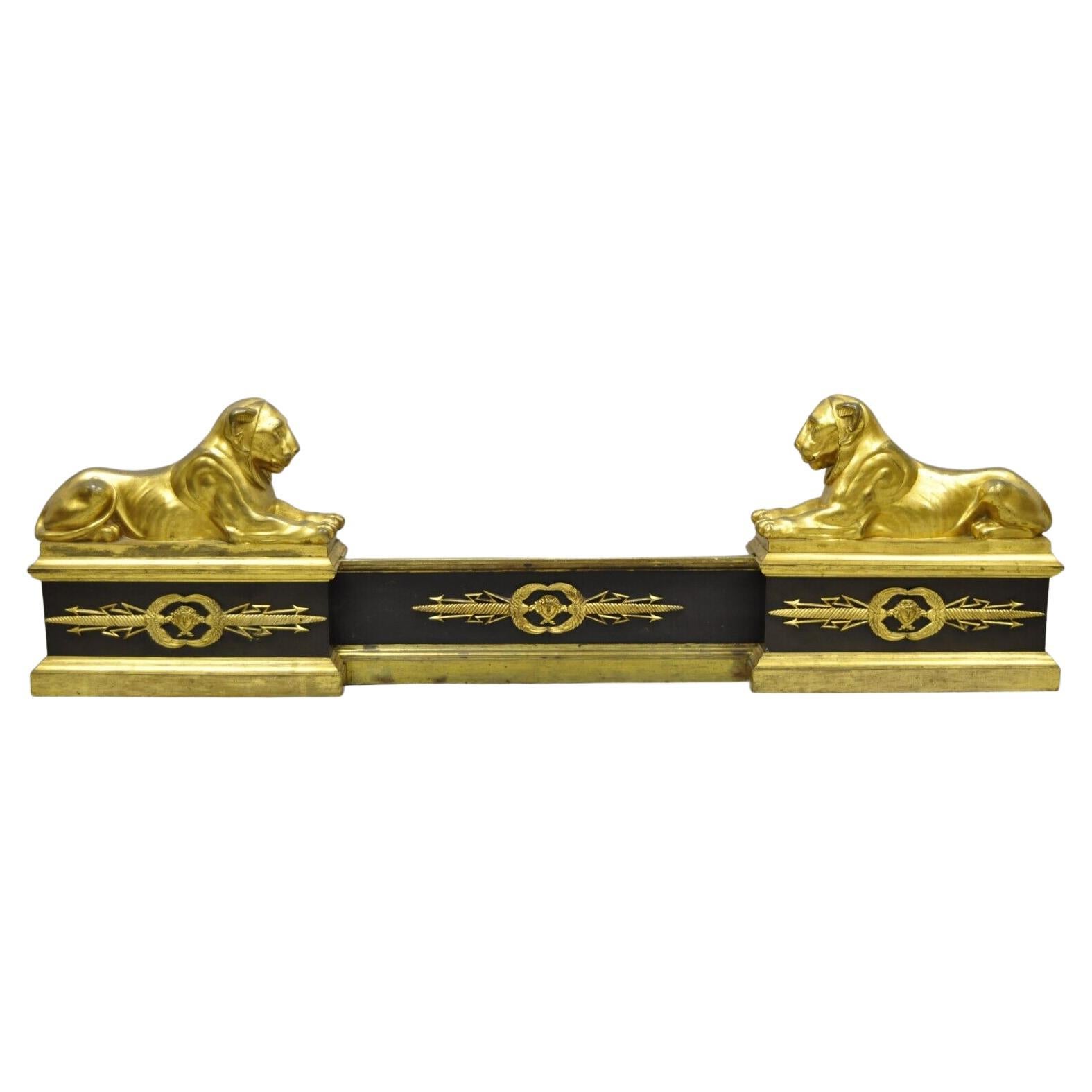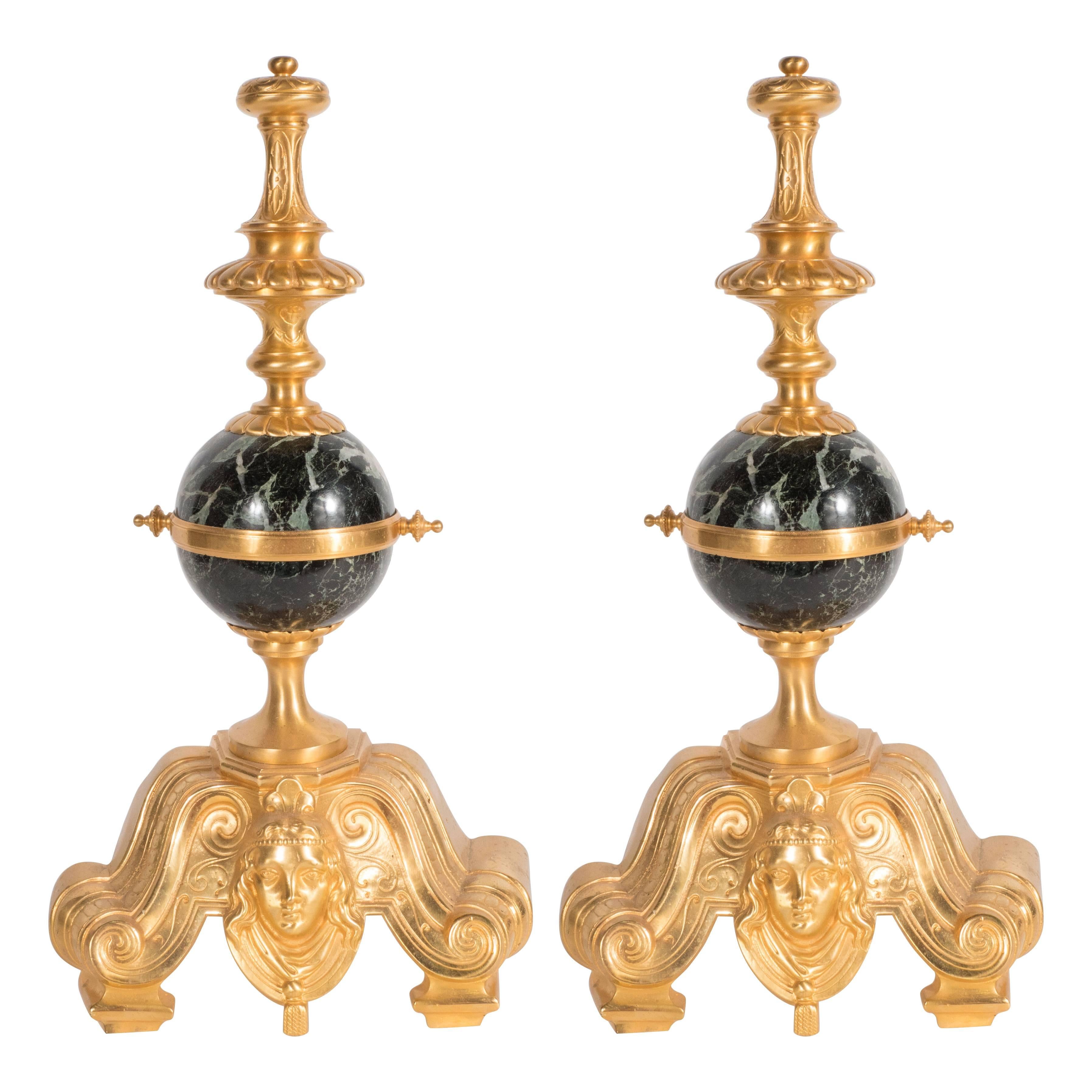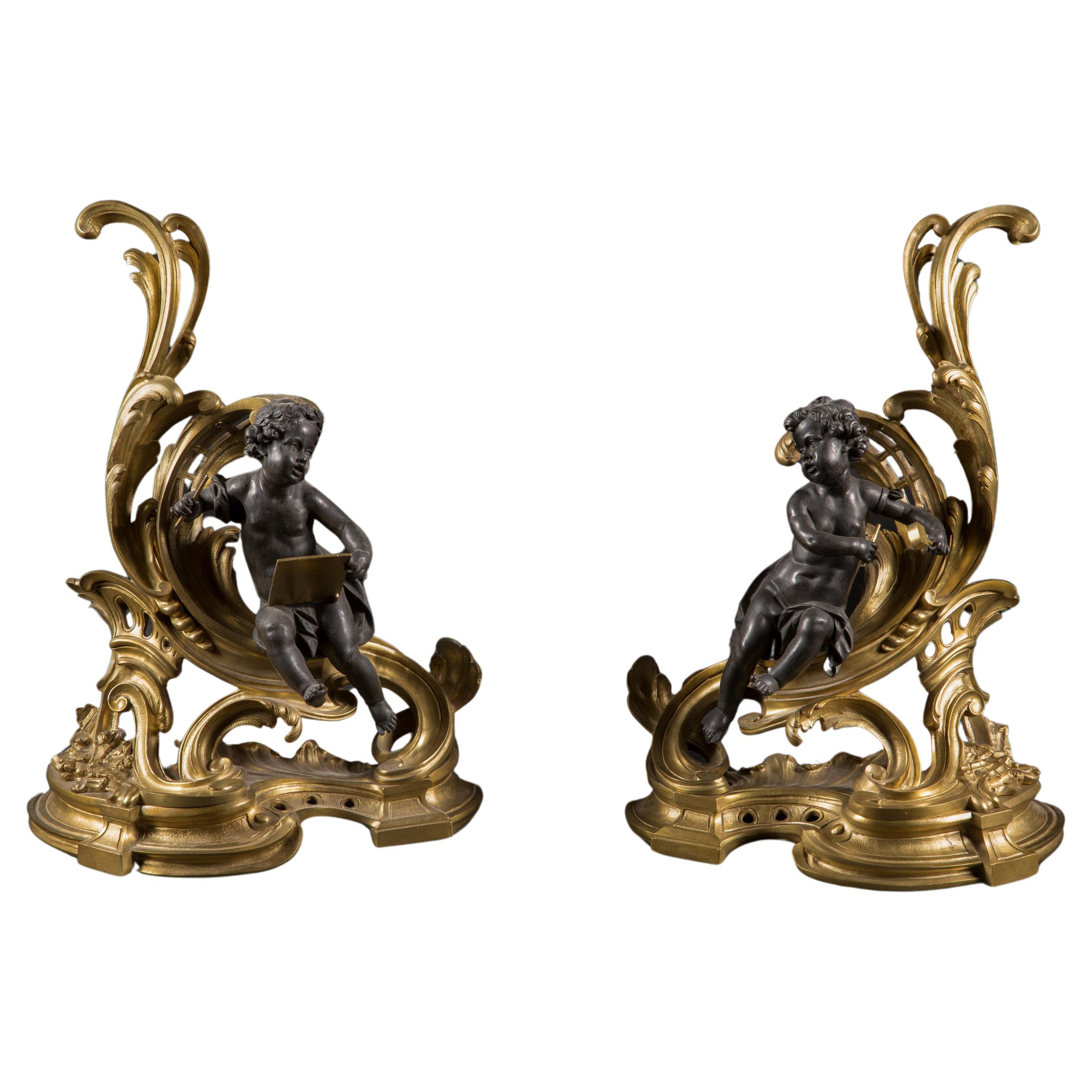Items Similar to Wonderful French Neoclassical Gilt Dore Bronze with Black Marble Insert Chenets
Want more images or videos?
Request additional images or videos from the seller
1 of 11
Wonderful French Neoclassical Gilt Dore Bronze with Black Marble Insert Chenets
About the Item
Wonderful French Neoclassical Gilt Dore Bronze with Black Marble Insert Chenets.
Measures: 12.5" W x 11" H x 19" D.
- Dimensions:Height: 11 in (27.94 cm)Width: 12.5 in (31.75 cm)Depth: 19 in (48.26 cm)
- Sold As:Set of 2
- Style:Neoclassical (In the Style Of)
- Materials and Techniques:
- Place of Origin:
- Period:
- Date of Manufacture:1920s
- Condition:Wear consistent with age and use.
- Seller Location:Roslyn, NY
- Reference Number:

About the Seller
4.9
Platinum Seller
These expertly vetted sellers are 1stDibs' most experienced sellers and are rated highest by our customers.
Established in 1990
1stDibs seller since 2012
1,180 sales on 1stDibs
Typical response time: <1 hour
- ShippingRetrieving quote...Ships From: Roslyn, NY
- Return PolicyA return for this item may be initiated within 3 days of delivery.
More From This SellerView All
- Wonderful French Empire Bronze Regency Fireplace Putti Cherubs Chenets AndironsLocated in Roslyn, NYWonderful French empire bronze Regency fireplace putti cherubs chenets andirons. Measures: 20" L x 7" W x 8" H.Category
Vintage 1920s French Regency Fireplace Tools and Chimney Pots
MaterialsBronze
- Wonderful French Bronze Neoclassical Fireplace Draped Fabric Chenets AndironsLocated in Roslyn, NYWonderful French bronze neoclassical fireplace draped fabric chenets andirons finished by Large Acorn finials. Measures: 8" H x 8.5" W x4&qu...Category
Vintage 1930s French Neoclassical Fireplace Tools and Chimney Pots
MaterialsBronze
- Wonderful Neoclassical French Gilt Bronze Marble Two-Tier Gueridon End TableBy Lorin MarshLocated in Roslyn, NYA wonderful neoclassical French gilt bronze and marble two-tier gueridon or end table. Purchased from Lorin Marsh.Category
20th Century French Neoclassical End Tables
MaterialsCarrara Marble, Bronze
- Wonderful French Dore Bronze Neoclassical Baltic Crystal Bowl Empire ChandelierLocated in Roslyn, NYA wonderful French dore bronze neoclassical style Baltic cut crystal bowl Empire chandelier with six-light and three internal lights.Category
Vintage 1920s French Neoclassical Chandeliers and Pendants
MaterialsCrystal, Bronze
- Wonderful French Empire Neoclassical Doré Bronze Purple Glass Crystal ChandelierLocated in Roslyn, NYA wonderful French empire / neoclassical doré bronze and purple glass center with crystal drops chandelier having 10 exterior and 5 interior l...Category
20th Century French Neoclassical Chandeliers and Pendants
MaterialsCrystal, Bronze
- Wonderful Pair French Empire Patinated Dore Bronze Swan Neoclassical SconcesLocated in Roslyn, NYA wonderful pair French empire patinated dore bronze swan neoclassical sconces.Category
20th Century French Neoclassical Wall Lights and Sconces
MaterialsBronze
You May Also Like
- A Neoclassical pair of Antique Signed Louis XVI Dore Bronze Fireplace ChenetsLocated in New York, NYA Neoclassical pair of Antique French signed Louis XVI style Dore Bronze Fireplace Chenets. The finials of the urns are stylized flames, with the swags and portraits combining to cre...Category
Antique 19th Century French Neoclassical Andirons
MaterialsBronze
- French Empire Neoclassical Bronze Lion Andirons Chenets with Fender, 3 Pc SetLocated in Philadelphia, PAAntique French Empire Neoclassical Bronze Lion Andirons Chenets with Fender - 3 pc set. Item features adjustable length, cast bronze reclining lio...Category
Antique 19th Century Neoclassical Andirons
MaterialsBronze
- Doré Bronze and Iron Regency ChenetsLocated in Norwood, NJUnusual pair of chenets, Regency style doré bronze and iron. Pair of fine quality, unusual chenets/andirons. Of bulbus form in the manor of a balustrade. Full and heavy in feel.Category
Antique Late 19th Century French Regency Andirons
MaterialsBronze, Gold Plate, Iron
- Antique Dore Bronze and Green Marble Bronze Louis XVI Style Chenets/AndironsLocated in New York, NYThis exquisite pair of antique chenets/ andirons was realized in France in the late 19th century. They represent an excellent example of the period. Created in a lustrous dore bronze, they feature rococo designs throughout and immaculately polished Italian green marble orbs at the center. The faces of two Greek revival female faces adorns the center panel between the two legs. Flanked by two scroll forms, she wears a pearl headpiece...Category
Antique 19th Century French Louis XVI Andirons
MaterialsMarble, Bronze
- Bronze dOré & Patinated Bronze Louis XV Chenets (Andirons), 19th Century FrenchLocated in New Orleans, LAThis magnificent pair of French Louis XV bronze chenets (andirons) date back to the 19th century. They feature patinated bronze putti, also known as cherubs, that rest on beautiful a...Category
Antique 19th Century French Andirons
MaterialsGold Plate, Bronze
- Pair French 19th Century Japonisme Style Gilt-Bronze & Marble Chenets, BouhonBy Bouhon Frères 1Located in Los Angeles, CAA fine pair of French 19th century Japonisme Louis XV style Gilt-Bronze and Marble Figural Chenets (Andirons) by BOUHON FRES, each depicting a flaming dragon atop an "L" shaped base surmounted with an allegorical gilt-bronze and marble urns with floral garlands and paw-feet, the base with a draped ormolu design and raised on tapered feet. Stamped: "B&H". Circa: Paris, 1890-1900. The bronziers Bouhon et Cie. Bouhon Frers. specialized in bronze-decorated fire-places and fire-fittings. These large and fine chenets are supreme examples of their output. The firm participated in the 1878 and 1900 Paris Expositions Universelles. Japonisme[a] is a French term that refers to the popularity and influence of Japanese art and design among a number of Western European artists in the nineteenth century following the forced reopening of foreign trade with Japan in 1858. Japonisme was first described by French art critic and collector Philippe Burty in 1872.[3] While the effects of the trend were likely most pronounced in the visual arts, they extended to architecture, landscaping and gardening, and clothing.[4] Even the performing arts were affected; Gilbert & Sullivan's The Mikado is perhaps the best example. From the 1860s, ukiyo-e, Japanese woodblock prints, became a source of inspiration for many Western artists.These prints were created for the commercial market in Japan. Although a percentage of prints were brought to the West through Dutch trade merchants, it was not until the 1860s that ukiyo-e prints gained popularity in Europe. Western artists were intrigued by the original use of color and composition. Ukiyo-e prints featured dramatic foreshortening and asymmetrical compositions. Japanese decorative arts, including ceramics, enamels, metalwork, and lacquerware, were as influential in the West as the graphic arts. During the Meiji era (1868–1912), Japanese pottery was exported around the world. From a long history of making weapons for samurai, Japanese metalworkers had achieved an expressive range of colours by combining and finishing metal alloys. Japanese cloissoné...Category
Antique Early 1900s French Japonisme Andirons
MaterialsMarble, Bronze, Ormolu
Recently Viewed
View AllMore Ways To Browse
Black Gilt
Black And Gilted Furniture
Neoclassical Gilt
Gilt Bronze Marble
Black Neoclassical
French Neoclassical Bronze
French Bronze Neoclassical
French Garden Bronze
Marble Insert
Neoclassical Gilted Bronze Marble
French Chenets
French Chenet
Gilt Chenet
French Gilt Bronze Andirons
Gilt Bronze Chenets
French Bronze Dore Chenets
Cast Iron Andirons American
Gothic Firedog





